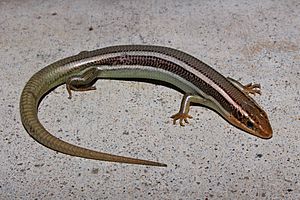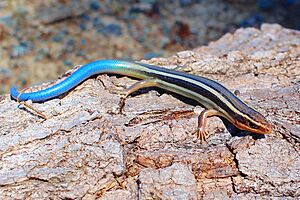Western skink facts for kids
Quick facts for kids Western skink |
|
|---|---|
 |
|
| Conservation status | |
| Scientific classification | |
| Genus: |
Plestiodon
|
| Species: |
skiltonianus
|
 |
|
| Synonyms | |
|
|
The western skink (Plestiodon skiltonianus) is a small, smooth-scaled lizard. It has small legs and can grow to be about 10 to 21 centimeters (4 to 8.25 inches) long, including its tail. This lizard is one of only five types of lizards found in Canada.
Western skinks love to warm up in the sun. They eat many different things, like spiders and beetles. If you try to pick one up, it might bite! They will quickly run away if they feel scared. These lizards are common but like to stay hidden. You can find them from southern British Columbia in Canada, all the way through many western US states like Washington, Oregon, and Nevada. They also live in parts of Arizona and even Texas. They prefer open areas and usually avoid thick forests. Western skinks can live from sea level up to very high places, about 2,130 meters (7,000 feet). They are active during the day when it's warm.
Contents
Meet the Western Skink: What's in a Name?
The Western skink was first described in 1852 by two scientists, Baird and Girard. It was named after Dr. Avery Judd Skilton, a doctor and naturalist. He was the first person to collect these lizards for study.
The Western skink belongs to a group of skinks called the "skiltonianus group." This group also includes the Gilbert's skink and the San Lucan skink. Scientists are still studying this group to understand their exact family tree, possibly using DNA tests.
There are three main types, or subspecies, of Western skinks:
- The Coronado skink (P.s. interparietalis) lives in southern California and Baja California, Mexico.
- The Great Basin skink (P.s. utahensis) is found in Utah.
- The Skilton's skink (P.s. skiltonianus) is the most common type. It lives across the western United States and in southern British Columbia, Canada.
Western Skink Behavior and Diet
The Western skink is a very quick and secretive lizard. It actively searches for food among fallen leaves and thick plants. They mostly eat small invertebrates. This includes spiders, many kinds of insects, and even sow bugs. Scientists have found crickets, beetles, moths, grasshoppers, and other arthropods in their stomachs. Sometimes, they will even hunt their prey, and there have been reports of them eating other skinks. They are good at digging and can make burrows several times longer than their own bodies.
Where Western Skinks Live: Habitat
Western skinks can be found in many different places, from sea level up to about 2,130 meters (7,000 feet) high. They are most common in open areas or places where new plants are starting to grow. They usually stay away from thick bushes and dense forests. These lizards seem to like places that are a bit damp, but they can also live on dry hillsides. You might find them in grasslands, open chaparral, or pine and juniper forests. Their nests are always in moist soil. They don't seem to need standing water nearby.
What Western Skinks Look Like
Adult Western skinks have a wide brown stripe down their backs. This stripe has black edges and is bordered by a noticeable whitish or beige stripe on each side. This pale stripe starts at their nose, goes over their eye, and runs along their body onto their tail. They also have another light stripe lower on each side, starting from their upper jaw. Between these two light stripes is a wide dark brown or black band. This band starts on the side of their head and usually goes far onto their tail. If a skink loses its tail and it grows back, this band might look different.
Young skinks have bright blue tails, which turn gray as they get older. During the breeding season, adult skinks might get reddish or orange colors on the sides of their head and chin. Sometimes, this color also appears on their tail. They usually have seven scales above their upper lip and four larger scales on the back of their neck. Young skinks have much brighter colors than adults.
Western Skink Geographic Range
Western skinks live from southern British Columbia, Canada, all the way down to the tip of the Baja California Peninsula in Mexico. They are also found across most of the Great Basin region, reaching into northern Arizona and central Utah. However, you won't find them in the middle of the San Joaquin Valley or most of the Sierra Nevada mountains in California. They are also absent from the hot lowland deserts of California. They can be found on several islands off the coast of California, like Santa Catalina and Todos Santos Island.
How Western Skinks Defend Themselves
Young Western skinks have a bright blue tail. This bright color fades as they get older. Skinks can drop their tail if a predator grabs it. This is called autotomy. The tail will wiggle violently, distracting the predator while the lizard escapes. The tail will grow back over time, but it's often darker and not perfectly shaped. Sometimes, a skink might pretend to be dead, but this is very rare.
Western Skink Life Cycle and Reproduction
Western skinks are active during the day when the weather is warm. In summer, they are most active in the morning and late afternoon. If summer temperatures are not too hot, they might stay active all day. Adult skinks usually become less active by early fall, but young skinks stay active for a few more weeks.
The time when these skinks reproduce changes depending on where they live and the year's conditions. Mating usually happens in the spring, soon after they come out of their winter hiding spots. Male skinks turn orange on their underside when they are ready to breed. Females lay 2 to 6 eggs in June or July. Western skink females dig nest chambers several centimeters deep in loose, moist soil. They usually make these nests under flat stones, logs, or sometimes near rocks.
Young Western skinks likely hatch in late summer. They might be able to reproduce when they are 2 years old, but most don't have babies until they are 3 years old. Western skinks can live for up to 10 years.
Images for kids





